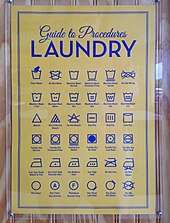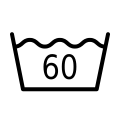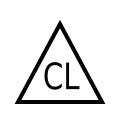Laundry symbol
A laundry symbol, also called a care symbol, is a pictogram which represents a method of washing, for example drying, dry-cleaning and ironing clothing. Such symbols are written on labels, known as care labels or care tags, attached to clothing to indicate how a particular item should best be cleaned. Standard symbols for these care labels differ by region. In some standards, pictograms coexist with or are complemented by written instructions.


The Canadian system was formerly based on color: green for "go ahead", yellow for "be careful", and red for "stop". That system was abandoned in favor of a common North American scheme.[1]
Although there is an international standard that has been agreed by the ISO and within Europe by the EU, copyright laws make it difficult to publish these widely. However, there have been attempts to summarize the main national and international standards.[2]
Europe
GINETEX, based in France, is the European association for textile care labeling, and formed in 1963 after academic conferences in the late 1950s were formed to define one standard of labeling.
General
The care label describes the allowable treatment of the garment without damaging the textile. Whether this treatment is necessary or sufficient, is not stated. A milder than specified treatment is always acceptable. The symbols are protected and their use is required to comply with the license conditions; incorrect labeling is prohibited. A bar below each symbol calls for a gentler treatment than usual and a double bar for a very gentle treatment.
Washing
A stylized washtub is shown, and the number in the tub means the maximum wash temperature (degrees Celsius). A bar under the tub signifies a gentler treatment in the washing machine. A double bar signifies very gentle handling. A hand in the tub signifies that only (gentle) hand washing (not above 40 °C) is allowed. A cross through washtub means that the textile may not be washed under normal household conditions.
In the European standard, the level of wash agitation recommended is indicated by bars below the washtub symbol. Absence of bar indicates a maximum agitation (cotton wash), a single bar indicates medium agitation (synthetics cycle) and a double bar indicates very minimal agitation (silk/wool cycle).[3] The bar symbols also indicate the level of spin recommended with more bars indicating lower preferred spin speed.[3]
 Washing symbol
Washing symbol Wash at or below 30 °C (USA, 1 dot, ●)
Wash at or below 30 °C (USA, 1 dot, ●) Wash at or below 40 °C (USA, 2 dots, ●●)
Wash at or below 40 °C (USA, 2 dots, ●●) Wash at or below 50 °C (USA, 3 dots, ●●●)
Wash at or below 50 °C (USA, 3 dots, ●●●) Wash at or below 60 °C (USA, 4 dots, ●●●●)
Wash at or below 60 °C (USA, 4 dots, ●●●●) Hand wash
Hand wash Don't wash
Don't wash
Bleaching
An empty triangle (formerly lettered Cl) allows the bleaching with chlorine or non-chlorine bleach. Two oblique lines in the triangle prohibit chlorine bleaching. A crossed triangle prohibits any bleaching.
 Bleaching symbol (allowed for both chlorine and non-chlorine bleach)
Bleaching symbol (allowed for both chlorine and non-chlorine bleach) Bleaching with chlorine allowed (obsolete)
Bleaching with chlorine allowed (obsolete) Non-chlorine bleach when needed
Non-chlorine bleach when needed Don't bleach
Don't bleach Don't bleach
Don't bleach
Drying
A circle in the square symbolizes a clothes dryer. One dot requires drying at reduced temperature and two dots for normal temperature. The crossed symbol means that the clothing doesn't tolerate machine drying. In the U.S. and Japan, there are other icons for natural drying.
Tumble drying
 Tumble drying symbol
Tumble drying symbol Tumble drying (low temperature)
Tumble drying (low temperature) Tumble drying (normal)
Tumble drying (normal) Do not tumble dry
Do not tumble dry
Natural drying
 Drying symbol
Drying symbol.svg.png) Line dry
Line dry.svg.png) Dry flat
Dry flat.svg.png) Drip dry
Drip dry.svg.png) Dry in the shade
Dry in the shade.svg.png) Line dry in the shade
Line dry in the shade.svg.png) Dry flat in shade
Dry flat in shade.svg.png) Drip dry in shade
Drip dry in shade
Ironing
The iron with up to three dots allows for ironing. The number of dots are assigned temperatures: one prescribes 110 °C, 2 for 150 °C, and 3 for 200 °C. An iron with a cross prohibits ironing.
 Ironing symbol
Ironing symbol Iron at low temperature
Iron at low temperature Iron at medium temperature
Iron at medium temperature Iron at high temperature
Iron at high temperature Do not iron
Do not iron
Professional cleaning
A circle identifies the possibilities of professional cleaning. A bar under the symbol means clean gently, and two bars means very gentle cleaning.
Chemical cleaning
The letters P and F in a circle are for the different solvents used in professional dry cleaning.
 Professional cleaning symbol
Professional cleaning symbol.svg.png) Dry clean, hydrocarbon solvent only (HCS)
Dry clean, hydrocarbon solvent only (HCS)s.svg.png) Gentle cleaning with hydrocarbon solvents
Gentle cleaning with hydrocarbon solventsss.svg.png) Very gentle cleaning with hydrocarbon solvents
Very gentle cleaning with hydrocarbon solvents.svg.png) Dry clean, tetrachloroethylene (PCE) only
Dry clean, tetrachloroethylene (PCE) onlys.svg.png) Gentle cleaning with PCE
Gentle cleaning with PCEss.svg.png) Very gentle cleaning with PCE
Very gentle cleaning with PCE Do not dry clean
Do not dry clean
Wet cleaning
The letter W in a circle is for professional wet cleaning.
.svg.png) Professional wet cleaning
Professional wet cleanings.svg.png) Gentle wet cleaning
Gentle wet cleaningss.svg.png) Very gentle wet cleaning
Very gentle wet cleaning Do not wet clean
Do not wet clean
References
- "Guide to Apparel and Textile Care Symbols". IC.GC.ca. Office of Consumer Affairs.
- files/Intertek/Divisions/Consumer_Goods/Media/PDFs/Services/Low%20Res%20CompleteCareLabelling.pdf "Caring About the Consumers Beyond the Label" Check
|url=value (help) (PDF). Intertek.com. Intertek. 2014. Retrieved 2014-04-20. - "Care Symbols". GINETEX.net. GINETEX. Retrieved 2018-03-21.
External links
| Wikimedia Commons has media related to Laundry symbols. |
- The International Association for Textile Care Labelling-Care Symbols
- ISO 3758:2012 – Textiles – Care labeling code using symbols
- Home Laundering Consultative Council - What Symbols Mean
- The revised Canadian standard
- Swedish care symbols
- United States care symbols
- Further care symbols, including Japanese
- US, Japanese, and UK woven washing label symbols
- Laundry Guide to Common Care Symbols – Textile Industry Affairs
- Guide to Common Home Laundering & Drycleaning Symbols – Textile Industry Affairs